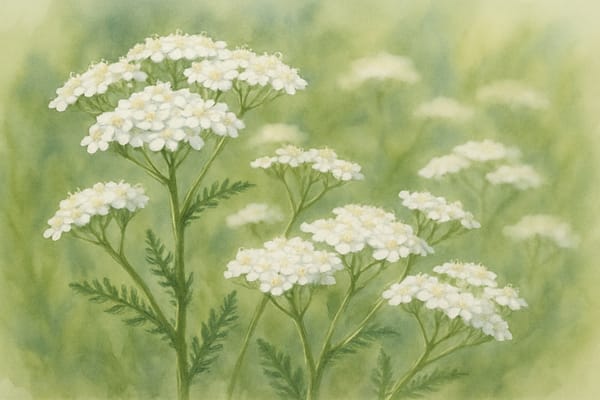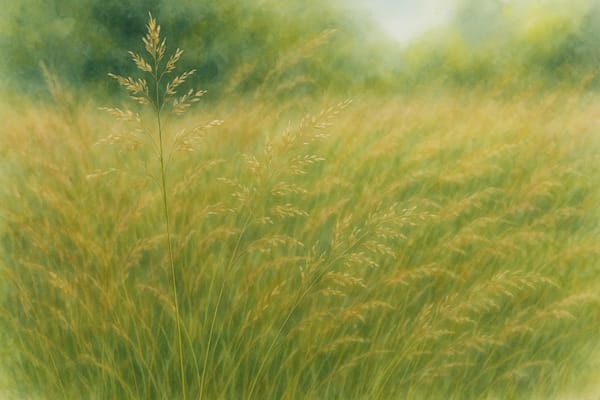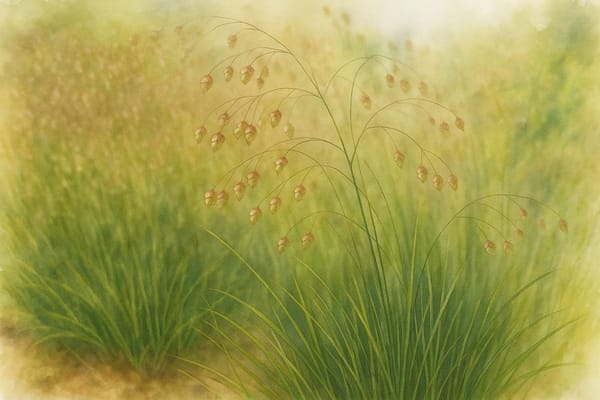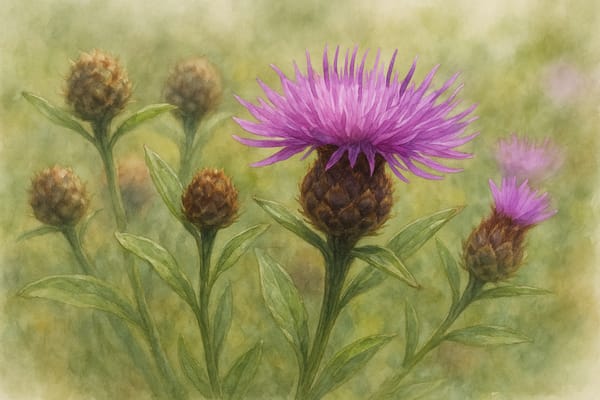In the sun-creased grasslands of Cornwall, where wildflowers flicker along hedgerows and verges, there is one plant that seems both ordinary and enchanted. Yarrow (Achillea millefolium) rises in silvery clumps, its fern-like leaves spreading low and fragrant beneath upright stems crowned with pale, domed umbels. These blooms—white, sometimes blushed with pink—hold more than nectar. They carry stories. Of ancient medicine, of hedge-witching, of battlefield wounds, of soil resilience and insect kinship. This is a plant with presence.
Yarrow is not rare, but neither is it forgettable. Its quiet ubiquity along Cornish hedges belies its historical depth and ecological importance. And in the modern garden, it returns as a botanical bridge—between past and future, cultivation and wildness, ornament and purpose.
A Plant with Thousand Leaves
The name “millefolium” means “thousand-leaf,” a reference to yarrow’s finely dissected foliage that feels more like soft lace than leaf. These feathery fronds unfurl in early spring and remain handsome well into winter. Crushed between fingers, they release an earthy, aromatic scent—something between sage, chamomile, and wild field. It is no surprise that birds have been known to line their nests with yarrow, perhaps instinctively drawn to its pest-repellent compounds.
In Cornwall, yarrow often grows to 50 or 60cm tall. Its stems are sturdy but pliant, its clusters of flowers wide and inviting. These blooms appear from June and continue, with intermittent flourish, into October. On mild coastal sites, flowers may open as early as May, drawn forward by sea warmth and lengthening light.
Thriving in Cornwall's Patchwork Soils
Cornwall is a place of geological contrasts—acid moorlands, calcareous cliffs, sandy dunes, and rich pastoral loam. Yarrow thrives in nearly all of them. From the steep, wind-bitten hedgerows of Penwith to the richer soils of inland meadows, it anchors itself with a tenacity that borders on miraculous.
It survives drought, salt-laced breezes, and grazing pressure. It spreads through rhizomes, forming persistent colonies that grip banks and bind thin soil. Its deep fibrous roots seek nutrients far below the surface, and its tolerance of soil pH—from 4.7 to 8—makes it a natural survivor in a changing climate.
This adaptability is not merely resilience. It is generosity. Yarrow stabilises disturbed ground. It softens the sharp lines of garden beds. It grows in the neglected corners and makes them seem intentional. It is as much a designer’s ally as a wildflower.
A Cornish Hedgerow Constant
In the Cornish landscape, yarrow often finds its place in the gaps between stone and sky. Cornish hedges, with their dry-stone cores and earthen shoulders, are home to many iconic species—red campion, foxglove, bluebell, knapweed. Yarrow mingles among them, its umbels rising through grasses and mosses like tiny solar systems.
Its value here is layered. It feeds hoverflies, lacewings, honeybees, solitary bees, beetles, skippers, and blues. Its seedheads feed finches in winter. It draws in the beneficial insects that feed on garden pests. It perfumes the hedgebanks in sun.
And then there is the visual rhythm: yarrow provides one of the longest-flowering intervals of any wildflower in the region. This makes it a cornerstone for continuous forage—an invisible thread sustaining the lives of pollinators from June into late autumn.
Medicine in the Milfoil
Known by names like “soldier’s woundwort” and “nosebleed plant,” yarrow’s reputation as a healer dates back thousands of years. Its Latin genus, Achillea, refers to Achilles, the Greek hero who supposedly used yarrow to treat battle wounds.
And the plant lives up to its legend. Its leaves are astringent, antiseptic, anti-inflammatory. Historically, they were chewed to relieve toothache, infused as tea to ease menstrual cramps, or applied directly to cuts to stop bleeding. Yarrow was used to bring down fevers, settle stomachs, and soothe arthritic joints. It was part of the herbal apothecary from Cornwall to the Caucasus.
In the folk traditions of Britain, including Cornwall, yarrow took on magical dimensions too. It was hung above doors to keep out sickness and bad luck. Slipped under pillows, it brought prophetic dreams. In Celtic lore, it was one of the “seven herbs of protection,” used in charms and healing rituals for body and spirit alike.
Even today, yarrow is treasured by herbalists and foragers. But in the garden, its benefits extend far beyond the medicinal.
Pollinator’s Banquet, Gardener’s Ally
Yarrow’s flowerheads are marvels of function. Each corymb—flat-topped, dense, and wide—contains dozens to hundreds of tiny composite flowers. These serve as nectar wells for insects with short tongues, including hoverflies, solitary bees, parasitic wasps, and soldier beetles.
The structure acts like a buffet: insects land easily, then move across the florets with minimal effort. Butterflies linger. Bees return. And predatory insects—drawn by pollen—help defend surrounding plants from aphids and other pests.
This makes yarrow one of the most efficient pollinator plants in any setting. It is a keystone in wildflower meadows, a companion in organic veg plots, and a magnet for life in any sunny patch.
Growing and Caring for Yarrow in the Cornish Garden
Yarrow is undemanding, but it rewards a little thoughtful placement. Choose full sun and well-drained soil for best flowering. Gravel beds, cottage borders, naturalistic lawns, and wildlife zones all suit its habit. It tolerates wind, salt, poor soil, and drought. It even does well in containers.
Plant 30 to 45cm apart, and give it room to roam. It spreads by rhizome and sometimes by seed. Cut back after the first flush to encourage rebloom, or leave the seedheads standing into winter for structure and bird food.
Divide every two to three years to maintain vigor. If plants become leggy or floppy, trimming early in the season (Chelsea chop-style) can encourage sturdier growth.
Wild vs. Cultivated: Choosing Your Yarrow
Wild Achillea millefolium in Cornwall is typically white, sometimes tinged with pink. It has that familiar feathery leaf and slightly woolly stem. Garden varieties, however, range widely in color—from soft yellows and apricots to deep reds and russets.
Some hybrids, like ‘Cerise Queen’ or ‘Terracotta,’ offer vibrant hues but may be less resilient than the native form. Others, such as Achillea filipendulina (fern-leaf yarrow), are taller with broader leaves and golden umbels.
If your garden ethos leans toward wildlife support and native restoration, the wild Cornish type is ideal. If color and contrast matter more, carefully chosen cultivars can blend the aesthetic with the ecological.
A Plant of Many Roles
In a single Cornish garden, yarrow might:
- Edge a sun-baked gravel path with soft, silvery movement.
- Thread through a mixed herbaceous border with echinacea, salvia, and grasses.
- Weave its umbels between cottage garden stalwarts like feverfew and scabious.
- Anchor a pollinator strip near fruit and veg beds.
- Bloom in a wildflower meadow alongside ox-eye daisy and bird’s-foot trefoil.
- Or simply grow, uninvited but welcome, in the lean earth of a Cornish hedge.
Wherever it appears, it holds its own with grace.
The Quiet Strength of Yarrow
Yarrow is not showy in the way of roses or dahlias. But it endures, supports, heals, and adapts—offering itself generously to insects, birds, gardeners, and landscapes alike. In Cornwall, it is part of the botanical vocabulary of place. In The Cornish Garden, it is a companion that offers structure, substance, and spirit.
To grow yarrow is to invite resilience, ecology, and history into your garden. It is a plant that remembers. And in a time when we look for ways to reconnect with nature, yarrow offers a quiet path—rooted in the land, lit by small white stars.











